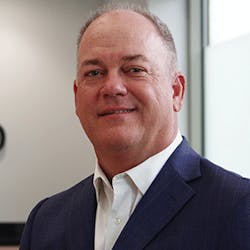Meet our 2021 ICT Visionaries from AT&T, Clearfield, CTC, Horizon, Lumen, Telia Carrier, TELUS, Verizon, and Viavi Solutions. These thought leaders will weigh in on all kinds of topics facing our industry in the April, July and October issues.
A few weeks ago, ISE sent to these 9 Visionaries 8 questions, asking them to select 3 to answer. Read on for their insights.
Topic: The Intelligent Edge
Deloitte predicts the global market for the Intelligent Edge will expand to $12 billion in 2021, continuing a CAGR of around 35%. Telecom providers deploying the intelligent edge for 5G networks, and hyperscale cloud providers optimizing their infrastructure and service offerings will drive this increase. Share your thoughts about this and why telecom providers must leverage the Intelligent Edge for success in the future.
The Intelligent Edge is the combination of advanced connectivity, compact processing power, and artificial intelligence (A.I.), located near devices that use and generate data.
(Source: https://www2.deloitte.com/content/dam/insights/articles/US93838_TMT_Predictions_2021/DI_2021-TMT-predictions.pdf)
Topic: Fiber
The fiber optic market is expected to grow at a 10% CAGR from 2019 to 2024. The major growth drivers for this market are increasing demand for the Internet and growing use of wireless systems. What are your company’s objectives related to this area in 2021? Share some tactical innovations you plan to use or are using that other providers could employ.
(Source: https://www.businesswire.com/news/home/20201214005458/en/Global-Fiber-Optics-Market-Report-2021-Trends-Forecast-and-Competitive-Analysis-2013-2024—ResearchAndMarkets.com)
Topic: 5G Health Perceptions
While extensive scientific evidence proves that mobile phone technologies have no adverse health impacts — not just for 5G but also earlier generations — 10% and 20% of adults in many advanced economies will mistakenly equate 5G with possible harm to their health. What can/should our industry do about this perception?
(Source: www.deloitte.com/us/tmtcenter)
Topic: Climate Goals
Verizon and Vodafone are aiming for net-zero emissions by 2040, and Telefónica has committed to net-zero in its top 4 operating markets by 2030. To get there, Verizon and Vodafone are targeting 50% reductions in electricity usage by 2025, and Telefónica a 70% reduction by 2030. What are some new network-related tools and tactics providers can employ to meet their climate goals?
(Source: https://res-www.zte.com.cn/mediares/zte/Files/PDF/white_book/202011241046.pdf)
Topic: SD-WAN
After experiencing slower growth in 2020 caused by the COVID-19 pandemic, worldwide sales of SD-WAN technologies are forecasted to grow at a compounded annual growth rate of 24% over the next 5 years. The market is expected to surpass $4 billion in 2025. What does this mean in terms of network changes for service providers?
(Source: https://www.delloro.com/news/sd-wan-market-growth-will-accelerate-in-2021/)
Topic: Planning, Designing, and Operations Improvements
During every stage of the 5G deployment journey, telecom providers are dealing with 5G’s increased complexity: more network nodes to install and maintain, more parameters to adjust, and more services to design and operate. This poses new challenges — from network planning to service operations. What are the challenges your company faces, and what are some creative network solutions/processes to address them?
Topic: Wireless CapEx Spending
The Wall Street analysts at Deutsche Bank Research say they expect wireless carriers — including T-Mobile, Verizon, and Dish Network — to collectively spend $35 billion on capital expenditures in 2021, a figure they said will rise by 6% to $37 billion by 2022. Do you think this is a reasonable forecast? Why or why not? How does this impact your company?
Topic: Virtual Health Care
The telecom industry has a large role to play in making virtual health care as widely available as possible. Although 90% of adult Americans and 73% of Americans over the age of 65 are connected to the Internet, both numbers should be higher in order to make universal access to video visits possible. This speaks to an ongoing problem of those who are underserved/unserved by high-speed broadband connectivity. What are some solutions to resolve this problem sooner rather than later?
Topic: Fiber
Fiber is foundational to our network today and tomorrow. It’s the backbone that powers our mobility network and is critical to creating a 5G network with dense coverage and enhanced capabilities. With Fiber, we serve customers via in-home fiber Internet, business fiber Internet, as well as wireless customers via mobile network backhaul. We continue to innovate what we do with AT&T Fiber. In 2021, we have a new AT&T Wi-Fi Gateway, that is tri-band and Wi-Fi 6 enabled. This new Gateway is available for select AT&T Fiber customers and is capable of providing Wi-Fi coverage that is faster and even more reliable when all devices are using Wi-Fi 6. It can also support more devices on the home Wi-Fi network and is prepared to support multi-gig speeds in the future.
Topic: Planning, Designing, and Operations Improvements
We’re deploying two types of 5G – Sub-6 and millimeter wave (mmWave). We’ve achieved nationwide Sub-6 5G coverage and deployed mmWave 5G in strategic, urban areas and venues with high-traffic areas where customers can benefit from ultra-fast speeds and the high capacity of mmWave 5G. With our FirstNet deployment, we’ve often used a one-touch deployment process, where we bundle and deploy several technologies simultaneously. Over the years, we’ve developed a strategic set of vendor relationships and use their capabilities to adjust our builds as needed. We also have wireline and wireless operation leads who work with jurisdictions around the country, local leaders and communities for our network build programs. After decades of deploying wireless networks, we’re still constantly looking for ways to enhance our processes and develop more automation tools as we deploy new technologies, such as 5G.
Topic: Wireless CapEx Spending
Wall Street analysts at Deutsche Bank Research have said the last time industry CapEx grew this fast was in 2013, amidst broader LTE rollouts. I believe this growth is largely attributed to exciting investments around 5G and over time, it’s expected to deliver new capabilities for customers such as increased bandwidth, faster speeds and less buffering online — from streaming entertainment, to playing games, to connecting with others. At AT&T, we invested more than $135 billion in our wireless and wireline networks between 2015 and 2019, including capital investments and acquisition of wireless spectrum and operations. Over this same period, we invested more in the United States than any other public company and we plan to continue investing in the network for our customers.
Topic: Climate Goals
Carriers are now taking the initiative to migrate their networks to greener architectures. These include Passive Optical Networks (PONs), collapsed networks and automated provisioning. PONs do not require powered electronics in the field, which not only reduces energy consumption, but also real estate, cooling, and maintenance costs. Clearfield® contributes to this effort by using FiberDeep® technology on our connectors that limit insertion loss to 0.2dB or less — half the value of typical connectors on the market. FiberDeep helps optical signals travel further but use less power.
Topic: Fiber
The best advice I can give is make it fast, get it passed, and make it last. As an example, we doubled the number of customer turn-ups in a neighborhood fiber build by dramatically speeding up installations using Clearfield plug-and-play products. Pulling only a single cable through duct from terminal to terminal, and using FieldShield® 12-fiber pushable MPOs to cascade YOURx™-Terminals, resulted in only 6 splice points — with 5 workers in 6 hours for 100 single family units. That’s making it fast. To get it passed takes funding. The initial steps taken by the FCC to fund $9.2B to the Rural Digital Opportunity Fund (RDOF) Phase 1 broadband deployments to 5.2 million unserved and underserved locations are encouraging. Finally, as the number of fiber deployments grows, so does the need for skilled technicians who’ve received proper training. The limited pool of existing certified technicians and the steep learning curve for future technicians can’t keep up with the demand. Plug-and-play solutions that provide quick and reliable installation of state-of-the-art fiber optic networks help shorten the learning curve and future-proof your network.
Topic: The Intelligent Edge
In order to implement multi-access edge compute (MEC), you need 3 things: a secure location (both logically and physically), a reliable power source, and lots of fiber. Clearfield sees an expanded role for high-density fiber active cabinets in this scenario. While active electronic equipment cabinets are not new for carriers, satisfying the high-count fiber requirement in tight spaces for MEC will rely on fiber management experts like Clearfield. Our FiberFlex and FAC cabinet portfolios are GR-487 compliant to accommodate extreme operating environments in the outside plant — a critical success factor for edge compute.
For more information, please email [email protected]. Follow Kevin on Twitter @kevinmorgan520 and LinkedIn @kevinmorgan1.
Topic: The Intelligent Edge
In 2020 CTC experienced the largest increase in Internet usage in our cooperative’s history. Regardless of a global pandemic, our members continue to find new opportunities to utilize the service: whether it’s virtual reality, IoT, telemedicine, remote work, distance learning, or business expansion. The increased demand puts a strain on networks and "instant performance" is increasingly expected from our members. Providers have an opportunity to utilize the intelligent edge to deliver extraordinary member experiences while simplifying network elements, reducing expenses, streamlining efficiencies, and improving reliability. Along with our partners, our goal is to use the Intelligent Edge to solve our members problems before they know they have a problem.
Topic: Fiber
Over the last 16 years CTC has deployed a 100% fiber-to-the-premises (FTTP) network to over 30,000 homes and businesses in Minnesota, providing our membership with the fastest, most reliable network available today. For the past 5 years CTC has also partnered with electric cooperatives, municipalities, and tribal government, to develop technology solutions and deploy FTTP services to their members. During 2021 we will continue to focus on helping our partners while growing and expanding our own fiber network.
I think there are innovative opportunities for existing networks, especially as it pertains to multi-dwelling units. Over the last 10 years we’ve refined the installation process for multi-tenant spaces and have found that fiber to each individual living space is a viable option — one that could provide additional business growth. Gone are the days of using existing four conducter wire to provide DSL speeds. FTTU may be the new FTTP.
https://www.goctc.com/services/internet/fiber-optics/, https://www.goctc.com/partner/
Topic: Virtual Health Care
This question is at the forefront of leader’s minds across the country but first we need a clear understanding of who is actually served, underserved, and unserved. Today’s data is not a clear representation of our communities. Until this problem is resolved at the federal level we will continue to have large swaths of rural America that will be ineligible for funding and lack a viable Internet option. Couple that with an aging rural population whose need for virtual health care services is increasing and finding a solution becomes even more critical. We are starting to move in the right direction but I’m afraid time will be the enemy of this process.
Topic: SD-WAN
SD-WAN might be the trendy new solution, but it does not come without its own set of challenges for providers to solve. At the end of the day it won’t replace the carrier network. Service providers will still design, engineer, build, and splice networks much like they do today. And customers will still buy Ethernet services as they are today. No matter how intelligent the SD-WAN is, it simply cannot replace underlying network quality and bandwidth capability.
Topic: Fiber
The easy answer here isn’t very innovative: we’ll build more fiber. Certainly COVID-19 pandemic remote working requirements haven’t hurt the prospective take rates for a FTTH deployment. It also goes without saying that no one wants a smaller pipe. Once you’ve acclimated to working with a higher bandwidth, it’s pretty difficult to adapt to slower speeds, so the increasing demands are no real surprise. Horizon has been, and will continue to be, a fiber optic broadband provider well into the future. Our mission, and the mission of many like us, is to deploy more fiber to more places continually. As needs increase, we will be there to meet the demand.
Topic: Wireless CapEx Spending
If I had the kind of crystal ball to know if this was reasonable, I would be playing the lottery! Unfortunately I don’t and I need to rely on industry analysts for guidance! It’s no shock that the world is demanding more bandwidth, more reliable connectivity, and in more places. The ongoing pandemic has actually increased the demand because of the changing behaviors or working or learning remotely and telehealth needs. To meet that demand, the wireless carriers will need to continue to accelerate their investment in both radio and fiber infrastructure. Otherwise, they will fall victim to their competition’s marketing! As a fiber optic broadband service provider, when these carriers need to expand their fronthaul and backhaul networks,
Horizon will be there to meet that increasing demand.
Follow Tammy on LinkedIn @tammy-perry-b9a62a8.
Topic: The Intelligent Edge
The Intelligent Edge opens the door to new and innovative applications that can take advantage of lower latency and performance by locating compute and storage much closer to a human or machine. This allows that human or machine to interact in enhanced or more efficient ways that may not have been possible in a more centralized cloud or datacenter. This Intelligent Edge opportunity distributes the demand for network and compute capabilities closer to the human or machine, requiring telecom providers to integrate and automate those capabilities within their metropolitan networks to provide the digital experience expected by their customers. The opportunity of the Intelligent Edge means that the coupling of network and compute will play a centralized role in a telecom providers value proposition.
Topic: SD-WAN
SD-WAN and the integration of Security and Policy control provides Enterprises the ability to maintain consistent and readily adaptable overlay topologies that abstract the underlying network infrastructures. This allows Enterprises to mix and match network access, core network, cloud and datacenter options based on their requirements without significant implications to their software-based topologies. For service provider networks, this means their networks must be equally flexible in their ability to be provisioned and adapted. Common-place Enterprise hub-and-spoke MPLS VPN topologies, without high-degrees of network automation and customer control, become impediments to SD-WAN deployments. The service provider must evolve these private MPLS VPN networks to be as flexible as any-to-any networks, like the Internet, so as to remain a viable option to Enterprise network infrastructures.
Topic: Fiber
Lumen continues an over-3-year-long program for overpulling its North America long-haul networks, placing low-loss SMF-28 fiber-optics into our expansive duct system to support the needs of Enterprises and hyperscalers. We’ve completed network wide builds and, in many cases, overpulling a second time over the same routes. Lumen is also investing extensively in its metropolitan networks, supporting 5G builds requiring dense fiber optic cable counts (1000+) for the expected growth in support for those programs. We believe Lumen is well positioned to satisfy the needs of Enterprises and hyperscalers with its extensive right-of-way and duct capacity, utilizing next-generation fiber optics and construction methods to meet the
hyper-growth needs of our customers.
Topic: SD-WAN
SD-WAN technologies are forecasted to grow with a compounded annual growth rate of 24% over the next 5 years, which will have quite an impact on Service Providers. The massive growth of online traffic during the COVID-19 pandemic has clearly shown that the public Internet is robust enough to take loads of traffic — and is an ideal underlay for all sorts of traffic, including an increased amount of Enterprise traffic that currently most likely sits under some sort of VPN or MPLS-based contract. The flexibility of the public Internet fits perfect with the way most Enterprises wants to run their network traffic. MPLS will still be there as a good solution for the smaller portion of traffic you want highly secure. If you’re also moving storage, applications, and workload, to the cloud then you have a future-proof solution to build on. All of this will have a major impact on how Service Providers need to serve their Enterprise customers.
Topic: Fiber
With a massive increase in traffic due to the COVID-19 pandemic, and adding 5G on top of this, it is clear that Service Providers will need more capacity and more diversity. More of this simply means more of fiber. New technologies within IPoDWDM solutions with 400G ZR implementations in dense metropolitan areas increase the need for fiber even further. While fiber in more dense areas are being built, the real issue is more in the long-distance areas across the US where the lack of fiber will become an issue in the coming years. Lack of ongoing building projects combined with the high cost of construction risks limiting the traffic growth — an area of concern that needs to be solved.
Topic: The Intelligent Edge
As a Carrier we will not build ourselves all the way to the very edge as that is more for others to build. We will still focus on picking up the traffic to bring it long-distance if needed. The main question for us is: who will actually build the real edge? Current domestic Service Providers (mobile or fixed), Local State/Regional Service Providers, hyperscalers, equipment manufacturers, or even completely new companies still not heard of? I would assume all categories mentioned have a great interest in building the edge, and this will have a huge impact on the telecom landscape.
Follow Mattias on Twitter @MFridstrom.
Global SolutionsTELUS
Topic: The Intelligent Edge
The Intelligent Edge allows telecom providers to use a perceived weakness as a key strength. Each point of presence in a community is now a strength, from a Central Office right down to an underground vault, these facilities allow for Edge computing very close to our customers. In the past, some of these facilities were viewed mostly as operational overhead. With the drive to the Intelligent Edge, our facilities create an opportunity to collaborate with hyperscalers. IoT in particular is one such area. Limited on-board computing combined with low latency requirements is a natural fit for Intelligent Edge computing over a more traditional centralized cloud solution. Telecom providers must leverage their existing assets in communities to bring the Intelligent Edge to our customers.
Topic: Fiber
For TELUS, building our fiber network is a generational investment. We’re building as fast as possible and we have aggressive targets for connecting customers to our network. Our speed and scale have been facilitated by several key IT system enhancements during the build, one such investment has been in our network inventory systems. Using our TELUS Network Automation product, all of our teams have a consistent and accurate view of our network as it is being planned, designed, built, used, and enhanced. Before we had access to this geospatial software, these processes were siloed with manual handoffs. Do not underestimate the role systems have in unlocking the value in network investment.
Topic: Planning, Designing, and Operations Improvements
5G has been an opportunity for TELUS to better integrate our wireless and wireline design teams. With our systems, roadmap and strategic investments in our TELUS Network Automation software, our RF design teams are able to plan sites collaboratively with our fibre design teams. Our proposed 5G sites are immediately visible to our fibre designers, and in some cases our system can automatically plan for fibre to feed a site. By removing that part of the complexity in our 5G design cycle, we can focus on bringing the benefits of 5G to our customers.
Follow Vishram on LinkedIn @faisal-vishram-8b4b7b41/.
Contact him at [email protected].
Verizon
Topic: The Intelligent Edge
We now have Verizon 5G Ultra Wideband service in parts of 67 cities where customers see download speeds up to 4Gbps. But it’s SO much more than peak speeds — our 5G will be able to support up to 1 million connected devices per square kilometer — eventually handling 10 to 100x more connected devices per square kilometer than 4G. This will allow cities to tap into the power of 5G for things like smart streetlights, remote security monitoring, intelligent transit, and smart parking solutions.
We’re building our 5G Ultra Wideband network to support breakthrough technologies for our customers. But we’re not just building the network, we’re supporting the entire ecosystem.
Verizon was first in the world to offer 5G network edge computing with AWS Wavelength — providing key developer partners the ability to create, test, and deploy applications that require ultra-low latency at the edge of our 5G network. We now have 10 cities live for developers with AWS Wavelength at Verizon’s 5G Edge. And we’re not done yet. Verizon has committed to launching 5G Edge in 10 more cities by the end of 2021.
Topic: Planning, Designing, and Operations Improvements
The health and safety of our employees and customers was paramount. We implemented safety protocols that were in line with federal and state guidelines. For frontline workers who served our customers it meant rethinking the way we operate. We quickly implemented touchless retail as well as hands-free, virtual, and no-contact methods for our Fios techs.
From the start of the COVID-19 pandemic, we reiterated our commitment to our 5G network, and we raised our CapEx guidance soon after the pandemic began in part to support this. As we continued forward with our 5G build out, we couldn’t achieve that goal without the support of forward-looking policymakers at the local, state, and federal levels who understand the need for policies that promote 5G while preserving the pivotal role of localities in managing public rights-of-way.
Topic: Virtual Health Care
I believe that this answer is simple: provide affordable broadband and free tutorials on how to use the capabilities. Once the broadband challenge is cared for, we could volunteer our time and share knowledge on how to use broadband for things such as telehealth, remote learning, and just keeping in touch with loved ones.
The COVID-19 pandemic has continued to reveal the inequities that exist for the underserved and the unserved such as senior citizens. Verizon is committed to creating a digitally inclusive and equitable society through its Citizens Verizon Initiatives.
Follow Shari on LinkedIn @shari-g-1854413.
Topic: The Intelligent Edge
5G, next-generation telecom, and hyperscale networks, are essential elements enabling The AI Era Revolution, which is about connected things enabling new verticals and full automation via machine learning and artificial intelligence. 5G is designed and architected to enable this revolution, in particular use cases requiring Ultra-Reliable Low Latency Communications — think connected cars.
Essential intelligence to react and enable new real-time services will move to the network edge, hence Intelligent Edge, which can be leveraged by telecom providers to offer cloud computing capabilities in close proximity to end users. Computing resources then can be used to process user data close to its source, rather than distant, centralized data-processing warehouses that form the traditional cloud environment. When data is processed near its source, the transmission latency can be reduced, as can the volume of data that must be hauled across the transport network to the cloud — resulting in satisfied customers and optimized networks.
Topic: Planning, Designing, and Operations Improvements
Critical to 5G delivery is programmability that allows dynamic resource assignment to corresponding tasks at any point in time and across the end-to-end network. To deliver both the incremental capabilities of 5G network programmability — compared to legacy networks — and to enable relevant cost savings, operators need the ability to disconnect peak and average utilization in terms of service delivery cost. They will be challenged to deliver service at peak utilization with the desired QoS. As usage scales down to a much lower level, the correlating resources assigned must scale back to align costs with traffic.
Operators also must meet a range of challenging, potentially contradictory, use cases on the same network with extraordinarily diverse characteristics in terms of data rates, latency, reliability, and number of connected devices. Autonomic monitoring, self-regulation, and intelligent adaptability — all are potential solutions, with artificial intelligence and machine learning as their cornerstones.
Topic: Fiber
Fiber technologies that enable 5G introduce a number of new challenges and testing considerations as they are layered into legacy networks. (See www.viavisolutions.com/en-us/5g) Finding the right expertise, management solutions, and tools is key to successfully scale evolving fiber networks. In 2021, VIAVI will work closely with industry leaders to enhance our portfolio of automated test solutions that help:
• Service providers launch, maintain, and monetize, networks with ease.
• Contractors close out jobs and settle payment quickly.
• NEMs achieve acceptance the first time.
Follow Dr. Yamany on LinkedIn @yamany.
Biographies and Company Information
Like this Article?
Subscribe to ISE magazine and start receiving your FREE monthly copy today!
Be sure your subscription is up-to-date for the next installments of this thought-leadership content:
Part 2 — July 2021
Part 3 — October 2021














